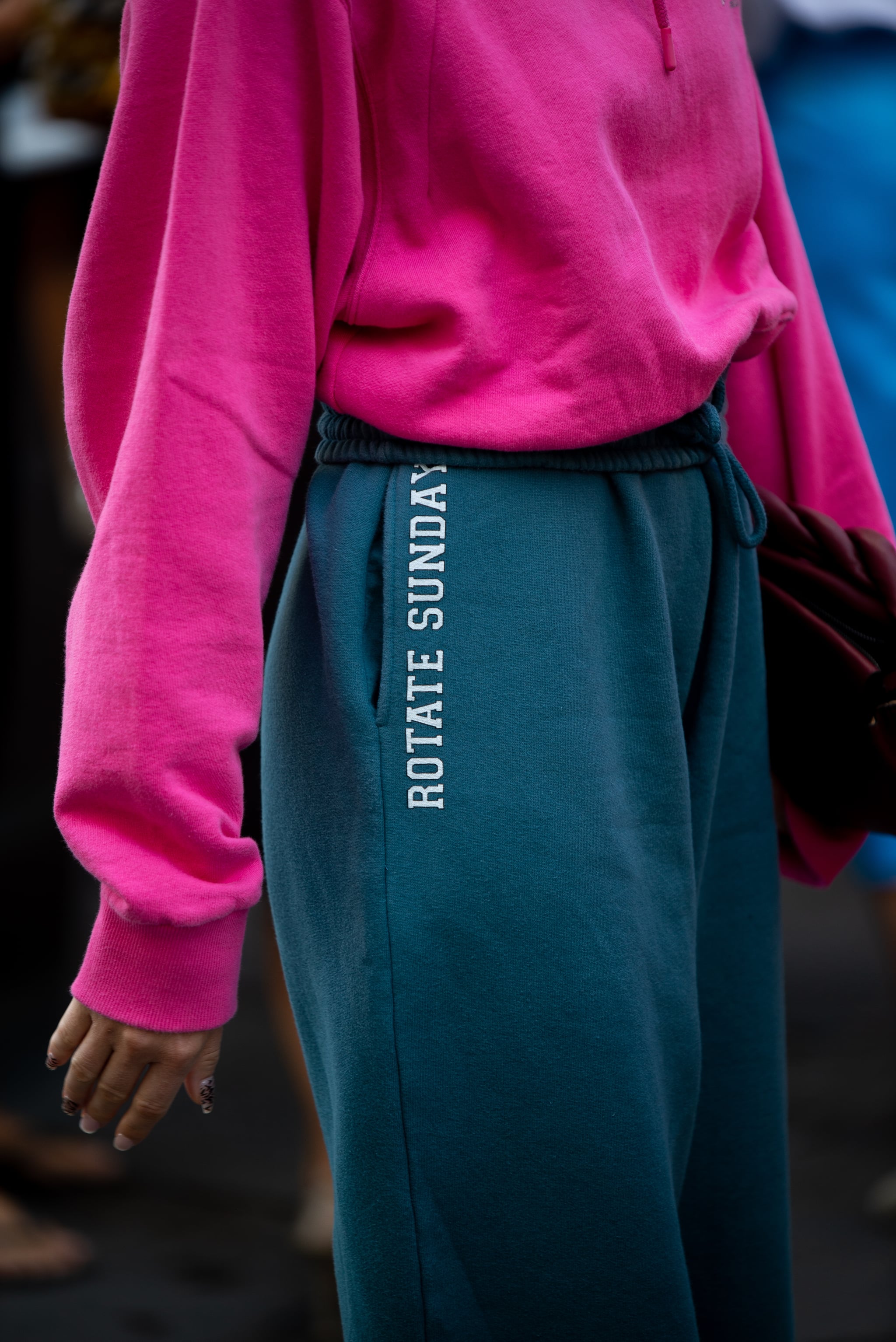What Will Shopping Look Like in 2021?
Image Source: Getty / Raimonda Kulikauskiene
You probably still remember that scene in The Devil Wears Prada, where Miranda Priestly coolly schools Andy Sachs on the trend cycle. You know, the one that made “cerulean” blue famous: “What you don’t know is that that sweater is not just blue, it’s not turquoise, it’s not lapis, it’s actually cerulean.” She says, glancing at Andy offhandedly. “You’re also blindly unaware of the fact that in 2002, Oscar de la Renta did a collection of cerulean gowns. And then I think it was Yves St Laurent, wasn’t it, who showed cerulean military jackets? And then cerulean quickly showed up in the collections of eight different designers. Then it filtered down through the department stores and then trickled on down into some tragic ‘casual corner’ where you, no doubt, fished it out of some clearance bin.”
That, in essence, is how a very select group of the fashion elite end up shaping an entire season of the way we dress. But what if 2020 flipped the script? What if shoppers more like Andy Sachs were the ones influencing collections? As major retailers shutter stores and designers pare down presentations and embrace wearability (and lots of loungewear), even Miranda Priestly would have to agree that idea isn’t so farfetched.
Shopping? During a Pandemic?
It was a fairly strange reality to be presented with: first the obvious threat of COVID-19, then staying home, and then staying home without an end in sight. Among the many other changes to our sense of normalcy, our dress code and our relationship to fashion changed dramatically, too.
Emily Holt, former Vogue editor and owner of the Bay Area’s beloved Hero Shop, felt the changes immediately — and not just because she spent the summer seeing and buying collections via Zoom. On the customer-facing side and in her stores, there was, as you’d expect, a monumental shift in shoppers’ needs and an initial gap between those needs and what the store could offer. “The things that [were] in the store were things that were bought before COVID. People [would] walk in and see what we [had] and, ask, ‘Where am I going to wear this?’ And it’s like, ‘Listen, I don’t know. I didn’t know this was happening. When I bought this, I thought you were going to be going to a wedding, but you’re not.’ So a lot of what [was] in the store, didn’t reflect our new reality because it was bought before all this,” Emily said when we chatted over the phone late this summer. That experience was shared by Pauline Montupe, owner of San Francisco boutique Shop Le Point, who agreed, “The idea of buying a dress for a date night or a nice top for work doesn’t apply anymore.”
” . . . that’s what people are looking for. Optimism and comfort and things that they can wear 24/7.”
Both Emily and Pauline, with intimate knowledge of their customers, set out to give their respective stores pandemic-appropriate make-unders, based on what was selling. For Emily, that started with a very specific piece: “What’s been interesting is the success of our Elder Statesman’s sweaters,” she said. “They’re not inexpensive. They are really high quality, very soft, very upbeat, optimistic cashmere sweaters. And the fact that they’re selling so well means that that’s what people are looking for. Optimism and comfort and things that they can wear 24/7.” Likewise, Pauline went to work, stocking in response to her shoppers. “Right off the bat in the first few months, we saw an uptick in all of our nonapparel — things like candles, skin care, and home goods,” she remembers. “Accessories like socks as well as activewear also [sold] really well. Since most of those categories we can order and receive immediately, we bulked up that section of the shop. As summer progressed, anything casual sold best, especially easy summer dresses you can just throw on when it is hot and not feel too fussy.” She took her cues from there, adding that “for prefall and fall, we started adjusting orders focusing on our bestselling brands and more casual items.”
As a boutique owner, Emily always feels a responsibility to curate for her customer, but more acutely now, “It’s up to us to be the translator and to distill what’s happening in the fashion industry for the real world and be the advocate for the consumer.” That means walking into one of these stores won’t necessarily reflect overarching seasonal trends but more specific pieces suited to a shopper’s way of life. On the heels of the COVID outbreak, that initially meant loungewear and even more interest in home and beauty categories, according to Pauline and Net-a-Porter’s senior fashion market editor Libby Page, who noted their customer’s “huge interest in beauty – tools and devices, skin care, and hair care, and more.”
Customers who have favored online “boutiques” like Net-a-Porter and Shopbop because of the luxe, curated selection they can have delivered to their door will find these retailers are more in tune with what they want to shop following the shift to staying at home. “We are working on a buy that is needed by our shopper, and that means timeless, stylish, and sophisticated looks that have a relaxed feeling for those who are still working from home,” Libby said. A visit to the Net-a-Porter homepage reflects just that. You’ll find a section highlighting what’s new, but also categories like “luxe loungewear” and “female-founded beauty” that put the emphasis on no-fuss dressing and self-care at home. Fast-fashion retailers like Zara similarly pivoted, with the brand increasing its offering of sweatpants and knit sets and most recently launching a lingerie category. Homebody clothes from “nap” dresses to sweatsuits weren’t just “trendy”; they belied our collective lifestyle shift.
So What DO We Want to Shop Now?
Months after the initial shock to the industry and our routines, changes have solidified, and trends in consumer behavior have cemented new fashion norms. The consumer is influencing what they want from retailers in real time, changing how buyers are stocking their shelves and how designers are reimagining their collections. Spring ’21 runways were the first real indication of that — the first time that designers were showing pieces created within the full context of the pandemic and its impact on our lifestyle. “Designers have really come into their own and have been doing things that work for them, and it shows through their clothes and presentation,” Libby said. “For example, Christopher John Rogers who usually shows at [Fashion Week] is taking his own spin on a presentation and showing in October. Designers who have adapted to the times and taken into consideration the new lifestyle today will be the ones who will remain successful.”
Indeed, Christopher John Rogers also notably introduced knitwear for the first time for spring ’21, giving his customer more practical clothing than his event-ready looks of seasons past. It’s not sweatpants or yoga pants; it’s an attempt to give shoppers something stylish but not contrived. Pauline put her finger on it, explaining, “Our customers don’t want to lose their fashion identities — they still want to ‘look cute’ and feel stylish, but they are reevaluating what they actually need in their wardrobes and looking for workhorses that don’t feel so precious.”
“Our customers don’t want to lose their fashion identities — they still want to ‘look cute’ and feel stylish, but they are reevaluating what they actually need.”
Among other things, the pandemic has illuminated the difference between those with innate interest in style and people who dress according to the trend cycle, for events, or out of obligation. As Emily pointed out, there are people who value “having a personal style and that idea of getting dressed for yourself. I think you’re [still getting dressed] if fashion is something you enjoy, and I think that people are finding ways to enjoy what they love. People who don’t enjoy fashion but had to participate because of their work or whatever they encountered in their lives are just not even giving it a second thought now.”
As we look ahead to what 2021 will bring, that’s the ethos that’s guiding new shopping habits. Even as things begin to open up and fashion becomes more relevant again, are there people who will opt out all together? Absolutely. But the people who have always loved fashion will continue to find reasons to buy clothes — not just sweatpants and loungewear — that fit their needs and their aesthetic, even if there isn’t a specific time or place they’re buying the pieces for.
Image Source: Getty / Raimonda Kulikauskiene
Who Are We Still Shopping For?
At the root of dressing for an occasion or a destination is the notion of being seen. When we’re not being seen, as has been the case over the past few months, the idea of keeping up with the Joneses has become less and less relevant: “I think over the past few years, there has already been a shift in what trends mean,” Pauline noted. “I feel like style has become more personal, and there is less of a prescribed trend each season. COVID will solidify this more . . . and style and trends will really become the way you want to look and feel.”
Looking at spring ’21 runways and holiday collections, we’re seeing that idea come to fruition. There’s more longevity in the designs and less clothing for one-time wear as buyers and designers answer the call to cater to shoppers’ personal style. Libby talked to us about how the concept of trends has “felt dated,” telling us “[consumers] will start to embrace and own their own personal style and provide it with seasonal updates.”
“Style and trends will really become the way you want to look and feel”
There’s a mindset shift at play that maybe we’ve all felt on an individual level before and certainly one that some brands have tried to capture (Cuyana’s “fewer, better things” mission statement comes to mind). But now it feels as though it’s been actualized more widely into our collective conscience and into the industry’s business practices. Simply put, there’s less appetite for trends and less feeding that trend cycle. Instead, we’re going to see people who just happen to love fashion, shopping what brings them joy.
As Emily said, “If I really, really love something, I know it will be part of me. I’ve been less concerned with what the events will be.” If that’s the impetus that’s guiding our choice to shop from here on out, if it’s not trends or places to be seen, then maybe the emphasis is not on what’s new and what’s next — on your calendar, the runway, or otherwise — but on seeking out what genuinely makes you happy and shopping more of that.
Image Source: Getty / Christian Vierig




